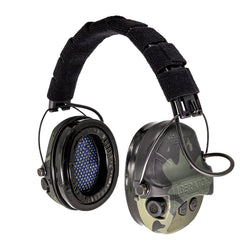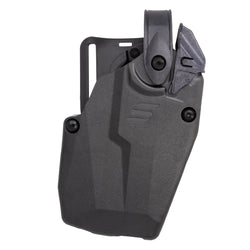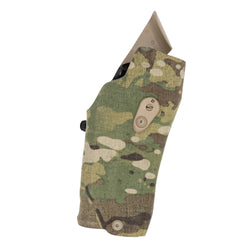I’ve recently started dabbling in long-range shooting. Not yet on a competitive level, but that’s the ultimate goal. As I’ve embarked on this journey, I’ve discovered a few helpful tools (thanks to some recs from the fine folks over at Vortex) that not only take some of the guesswork out of punching out to longer ranges, but are essential to successfully delivering an effective shot on target.
If you’re new to this like I am, this article is a friendly tour of the practical things I’ve learned so far: the principles that matter, gear that actually moves the needle, and a few habits that make practice productive.
Let’s take a looksie.
Principles of Long-Range Shooting
Long-range shooting is all about physics. And patience.
At the most fundamental level, you’re managing three variables: the projectile (ballistics and stability), the platform (rifle, barrel, and optic), and the environment (distance, wind, and general weather conditions). Get those three right and the rest kinda falls into place. Ignore one or take it for granted, and you might get a few lucky shots with none of the repeatability that defines true skill. It’s a balance; a fine line. But I think that’s what makes it so dang fun.
Your ammo choice is really a great place to start. It’s doing a majority of the heavy lifting here, and that ballistic data printed on your ammo box is going to mean a hell of a lot more to you now than ever before. The two numbers you’re going to care most about are muzzle velocity and ballistic coefficient.
Muzzle velocity determines how flat the bullet’s arc will be and how long it takes to reach the target, directly affecting how much you have to compensate for gravity. The ballistic coefficient, on the other hand, is a measure of how well the bullet cuts through the air and resists wind.

But a word of caution: the numbers printed on the box are often a best-case scenario, and a chronograph is definitely going to come in handy as you average velocities and identify and compensate for bullet deviation.
That’s probably a huge oversimplification, and I probably butchered it. But hopefully, you get the point: numbers matter.
Accuracy & Repeatability Matter
In casual conversation, accuracy and repeatability are often used interchangeably, but in long-range shooting, they are entirely different animals. While accuracy (the ability to deliver tight groups precisely where you want them) is important, repeatability is the priority.
Repeatability is the discipline of ensuring you apply the same inputs consistently to produce the same outputs with every single trigger pull. If you can’t repeat your results, your “accurate” shot might just be more of a bit of beginner’s luck than anything.
Repeatability starts with you, the shooter. Your cheek weld, head position, and the way you breathe and pull the trigger need to become part of your muscle memory. Any rushed trigger pull or slight flinch can introduce vertical or horizontal deviation that appears to be a rifle problem but is actually a human one. By focusing on your form and maintaining consistency, you remove a major variable from the equation.
Your setup is equally important. A rifle that returns to zero after adjustments, a scope that reliably holds its zero, and ammunition that behaves consistently are the mechanical half of repeatability. Swapping components or changing torque values without logging the change introduces drift. And drift equals inconsistency rather than repeatability. A big no-no, right?
There’s also an art to finding the balance with your rifle and its ammo preferences. A load that shoots excellent groups in one rifle can be mediocre in another, and even within the same gun, different lots of the same ammo can vary. That’s why chronograph strings and group testing aren’t really optional. If you can’t be bothered to test and log, prepare to be frustrated. That’s just how it is.
All of this is to say that if you really want to punch out to longer ranges and move away from taking lucky potshots, measure and record. Train for repeatability, and your accuracy will follow.
Long-Range Essentials
You can get into the game of long-range shooting without spending a fortune. As with any sport, there’s always an urge to chase the best, most expensive gear. I get it. But as I’ve learned, the most important thing is to build a setup that is both consistent and predictable; one that provides reliable feedback on what’s working and what’s not.
And that doesn’t necessarily come with a hefty price tag.
My philosophy has been to assemble a stack of gear that removes variables, rather than creating them. When a shot goes wide, I want to be able to determine if it’s due to my own error, the wind, or a faulty calculation, rather than because my scope’s adjustments were sloppy or my rifle’s barrel was unpredictable. The following tools have helped me get to a place of predictability and consistency, and have been essential to my long-range journey.
The Right Rifle/Optic Combination
It all starts with the rifle/optic combination. After all, it is the delivery system, and it has to be predictable. Barrel quality, length, and harmonics all affect where your rounds will go, and a consistent action-to-stock fit will help keep your groups tight. Small details, such as bedding and torque settings, are worth the fuss because they eliminate variables, which is more important than you probably realize.
I went with my Savage 110 Tactical chambered in .308 Winchester and topped with a Vortex Venom 5-25×56 scope. It’s not everyone’s first choice, I’m sure, but it’s worked out well for me thus far.

The Savage 110 is a great starter rifle for a few reasons. The barrel is a solid performer for the price, the AccuTrigger is fantastic for a clean break, and the rifle has a reputation for consistency. And the Vortex Venom scope is a great match. It has the magnification I need to see my target at +/- 1,000 yards, a clear image, and, most importantly, reliable turrets that I can trust to hold zero.
Needless to say, this combo has been a great platform for me to learn the fundamentals of long-range shooting.
At the recommendation of our good friends at Vortex, I also picked up a Ruger Precision Rimfire rifle in .22 LR, topped off with a Vortex Diamondback Tactical 4-16×44. This is great for two reasons: one, to save money on ammo, and two, to practice long-range fundamentals at my more local ranges, where 100-yard bays are standard.
While shooting at 100 or 150 yards isn’t exactly “long-range,” the principles are the same, and this handy little rimfire rifle has been a great tool to work on the basics of trigger control, reading wind at short distances, and making repeatable adjustments on the scope.
Plus, a box of .22 LR ammo costs a fraction of .308, so you can train more for less. It’s a great way to drill the mechanics of shooting without the distraction of heavy recoil or the fear of burning through expensive ammo.
A no-brainer, really.
Match Loads
You can buy some of the most expensive gear on the market, but if your ammo is inconsistent, well… you get the point. You need to find a load your rifle likes and stick with it. It’s also important that the ballistic data on your ammo box is consistent with the velocity you get from your barrel.
My go-to has been Hornady Superformance 168-grain ELD Match .308 ammo, graciously provided by the fine folks over at Ammo To Go. It’s a high-quality, factory-loaded round with a high ballistic coefficient, making it an excellent choice for long-range shooting.
Once you have your preferred ammo, you’ll want to run a chronograph to see how it performs out of your rifle. Muzzle velocity is a critical component of accurate ballistic calculations.
A chronograph will tell you the average velocity and how consistent your rounds are, giving you a real-time snapshot of how your ammo is performing. Consistency is key here. Without this data, your ballistic calculator is working with a big assumption, and your results will suffer for it.
Range Finders, Weather Meters & Ballistic Calculators
We’ve already established that long-range shooting is a game of physics and math. Neither of which was my strong subject in school. The good news, however, is that we have modern tech that does a lot of the heavy lifting. Things like range finders and ballistic calculators.
Distance is simple if you have a decent rangefinder and even a rudimentary understanding of gravity.
I’ve been leaning pretty heavily on my Vortex Crossfire HD 1400 Rangefinder as I’ve gotten more comfortable at the range. It gives you an accurate distance to your target, which is the first variable in any long-range shot. Without an accurate range, everything else is just a guess. You can be the best marksman in the world, but if you think your target is at 600 yards when it’s actually 625, you’ll miss every time.

However, wind is not nearly as forgiving. The same can be said for temperature, barometric pressure, and altitude, which change air density and can either increase or decrease drag. This is where tools like a Kestrel weather meter or learning to read wind can make all the difference.
But balancing all of that data can be a bit of a challenge without a ballistic calculator. I’ve been using the GeoBallistics mobile app, and it’s been a real lifesaver. It takes all the data you’ve collected, such as muzzle velocity, ballistic coefficient, distance, and environmental conditions, and gives you an accurate firing solution, telling you exactly how many clicks of elevation and windage you need to dial on your scope to hit your target.
Spotting Scopes
Spotting scopes (and a dedicated spotter, of course) are key for seeing your hits and helping you read the wind. My Vortex Crossfire HD Spotting Scope has been essential to my training. It’s a great “truth teller” for every shot, confirming whether I’ve missed high, low, left, or right.

It’s an invaluable tool for getting feedback on your shots, especially when you can’t see the bullet impact on the target with your rifle scope. This allows you to immediately correct your next shot based on real-time feedback.
That said, please, for the love of all that is holy, please invest in a quality tripod for your spotting scope. I made the rookie mistake of trusting my SmallRig tabletop tripod that I typically use for my DSLR camera, but quickly discovered that its short, squatty legs were no match for the weight (and awkward shape/weight distribution) of my spotting scope.
A sturdy, purpose-built tripod, like the Vortex Ridgeview Carbon tripod, is a solid option. It’s lightweight and easy to carry, and it pairs flawlessly with the Crossfire HD spotting scope and tracks nice and smooth. Seriously, it’s a smart buy.
Other Considerations
We’ve covered long-range shooting gear at length, I think, and we’ve discussed the principles as well. However, there are a few other, less tangible factors that have helped me a bit with the learning curve. These aren’t necessarily things you can buy, but they are things you need to do to make all the other stuff actually matter.
A Central Data Log
If you take one piece of non-gear advice from this article, let it be this: Log everything. Write it down, all of it. Your rifle, optic, and ammo are only as good as the data you collect on them. I know we’ve already hit on this a time or two, but I just can’t stress it enough. Every serious long-range shooter keeps a detailed logbook, and you should too.
Log your ammo use, range conditions, exact distances, any deviation from your zero in terms of elevation and windage, and any maintenance done, including cleaning. Everything matters.
Seriously, treat your logbook like a sacred text. Reviewing it is the fastest way to turn a frustrating miss into a valuable lesson. It helps you find those subtle drifts in your load or identify a bad habit in your form.
The Power of the Spotter
I mentioned spotting scopes, but you also need a dedicated and trained spotter as you start punching out to further distances. Shooting is a complex task, and trying to manage your shot process, watch your target, and spot your own miss is incredibly difficult. Having a dedicated spotter allows you to focus entirely on repeatability.
Parting Shots
Getting serious about long-range shooting doesn’t mean buying the most expensive kit on the shelf. It means putting together tools that let you measure reliably, then using those measurements to deliver repeatable and consistent shots on target.
For me, that meant centering everything on the Savage 110 Tactical in .308 with the Vortex Venom 5-25×56, running Hornady 168-grain ELD Match ammo, rangefinding with the Vortex Crossfire HD 1400, calculating with the GeoBallistics app, and spotting impacts with the Vortex Crossfire HD 16-48×65 on a Ridgeview Carbon tripod. My kit wasn’t less about flash, and more about function, repeatability, and reliable feedback.
Sure, it’s Vortex heavy, but that should be no surprise by now. I’m a Vortex loyalist, plain and simple.
Regardless of my loyalties and biases, my kit has provided me with a predictable setup, allowing me to focus more on the fundamentals and refine my marksmanship skills without breaking the bank. That’s really what we care about, right?
If you’re starting a similar path, prioritize optics that hold zero and give clear adjustments. Choose a match load you can chronograph to get real-world velocity data. Use a rangefinder and ballistic app so your choices are always data-backed.
Practice deliberately, log everything, and use your spotting scope as the truth-teller for each correction. Misses will happen. Don’t get discouraged. Learn from them and let the kit you trust deliver the feedback you need to grow.
Safe shooting, and see you downrange.









